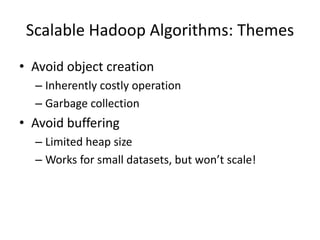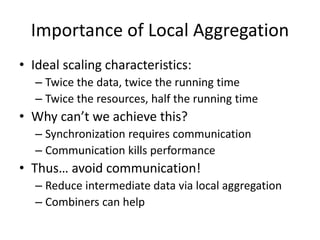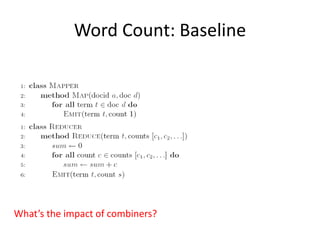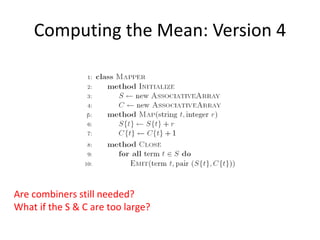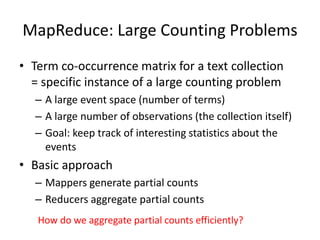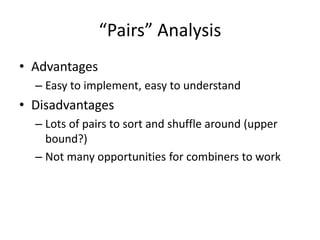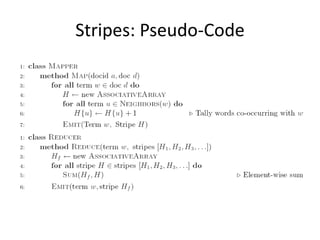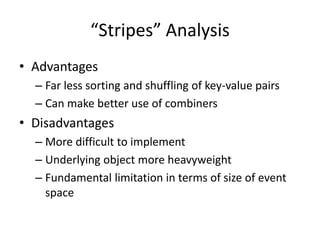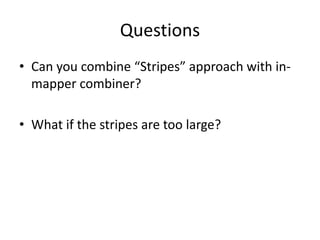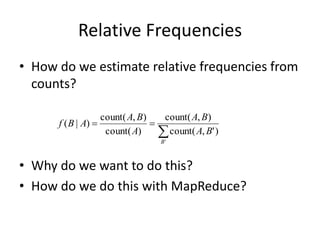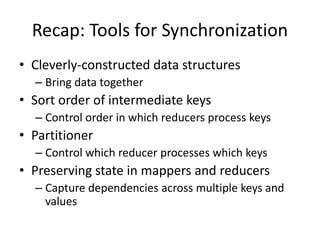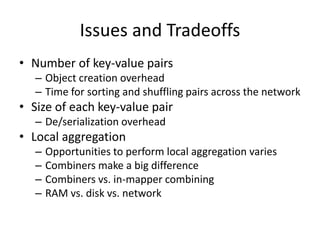MapReduce Algorithm Design - Parallel Reduce Operations
- 2. MapReduce: Recap • Programmers must specify: map (k, v) → <k’, v’>* reduce (k’, v’) → <k’, v’>* – All values with the same key are reduced together • Optionally, also: partition (k’, number of partitions) → partition for k’ – Often a simple hash of the key, e.g., hash(k’) mod n – Divides up key space for parallel reduce operations combine (k’, v’) → <k’, v’>* – Mini-reducers that run in memory after the map phase – Used as an optimization to reduce network traffic • The execution framework handles everything else…
- 3. “Everything Else” • The execution framework handles everything else… – Scheduling: assigns workers to map and reduce tasks – “Data distribution”: moves processes to data – Synchronization: gathers, sorts, and shuffles intermediate data – Errors and faults: detects worker failures and restarts • Limited control over data and execution flow – All algorithms must expressed in m, r, c, p • You don’t know: – Where mappers and reducers run – When a mapper or reducer begins or finishes – Which input a particular mapper is processing – Which intermediate key a particular reducer is processing
- 4. combine combine combine combine b a 1 2 c 9 a c 5 2 b c 7 8 partition partition partition partition map map map map k1 k2 k3 k4 k5 k6 v1 v2 v3 v4 v5 v6 b a 1 2 c c 3 6 a c 5 2 b c 7 8 Shuffle and Sort: aggregate values by keys reduce reduce reduce a 1 5 b 2 7 c 2 9 8 r1 s1 r2 s2 r3 s3
- 5. Tools for Synchronization • Cleverly-constructed data structures – Bring partial results together • Sort order of intermediate keys – Control order in which reducers process keys • Partitioner – Control which reducer processes which keys • Preserving state in mappers and reducers – Capture dependencies across multiple keys and values
- 6. Preserving State Mapper object configure map close state one object per task Reducer object configure reduce close state one call per input key-value pair one call per intermediate key API initialization hook API cleanup hook
- 7. Scalable Hadoop Algorithms: Themes • Avoid object creation – Inherently costly operation – Garbage collection • Avoid buffering – Limited heap size – Works for small datasets, but won’t scale!
- 8. Importance of Local Aggregation • Ideal scaling characteristics: – Twice the data, twice the running time – Twice the resources, half the running time • Why can’t we achieve this? – Synchronization requires communication – Communication kills performance • Thus… avoid communication! – Reduce intermediate data via local aggregation – Combiners can help
- 9. Shuffle and Sort Mapper Reducer other mappers other reducers circular buffer (in memory) spills (on disk) merged spills (on disk) intermediate files (on disk) Combiner Combiner
- 10. Word Count: Baseline What’s the impact of combiners?
- 11. Word Count: Version 1 Are combiners still needed?
- 12. Word Count: Version 2 Are combiners still needed?
- 13. Design Pattern for Local Aggregation • “In-mapper combining” – Fold the functionality of the combiner into the mapper by preserving state across multiple map calls • Advantages – Speed – Why is this faster than actual combiners? • Disadvantages – Explicit memory management required – Potential for order-dependent bugs
- 14. Combiner Design • Combiners and reducers share same method signature – Sometimes, reducers can serve as combiners – Often, not… • Remember: combiner are optional optimizations – Should not affect algorithm correctness – May be run 0, 1, or multiple times • Example: find average of all integers associated with the same key
- 15. Computing the Mean: Version 1 Why can’t we use reducer as combiner?
- 16. Computing the Mean: Version 2 Why doesn’t this work?
- 17. Computing the Mean: Version 3 Fixed?
- 18. Computing the Mean: Version 4 Are combiners still needed? What if the S & C are too large?
- 19. Algorithm Design: Running Example • Term co-occurrence matrix for a text collection – M = N x N matrix (N = vocabulary size) – Mij: number of times i and j co-occur in some context (for concreteness, let’s say context = sentence) • Why? – Distributional profiles as a way of measuring semantic distance – Semantic distance useful for many language processing tasks
- 20. MapReduce: Large Counting Problems • Term co-occurrence matrix for a text collection = specific instance of a large counting problem – A large event space (number of terms) – A large number of observations (the collection itself) – Goal: keep track of interesting statistics about the events • Basic approach – Mappers generate partial counts – Reducers aggregate partial counts How do we aggregate partial counts efficiently?
- 21. First Try: “Pairs” • Each mapper takes a sentence: – Generate all co-occurring term pairs – For all pairs, emit (a, b) → count • Reducers sum up counts associated with these pairs • Use combiners!
- 23. “Pairs” Analysis • Advantages – Easy to implement, easy to understand • Disadvantages – Lots of pairs to sort and shuffle around (upper bound?) – Not many opportunities for combiners to work
- 24. Another Try: “Stripes” Idea: group together pairs into an associative array Each mapper takes a sentence: Generate all co-occurring term pairs For each term, emit a → { b: countb, c: countc, d: countd … } Reducers perform element-wise sum of associative arrays (a, b) → 1 (a, c) → 2 (a, d) → 5 (a, e) → 3 (a, f) → 2 a → { b: 1, c: 2, d: 5, e: 3, f: 2 } a → { b: 1, d: 5, e: 3 } a → { b: 1, c: 2, d: 2, f: 2 } a → { b: 2, c: 2, d: 7, e: 3, f: 2 } +
- 26. “Stripes” Analysis • Advantages – Far less sorting and shuffling of key-value pairs – Can make better use of combiners • Disadvantages – More difficult to implement – Underlying object more heavyweight – Fundamental limitation in terms of size of event space
- 27. Cluster size: 38 cores Data Source: Associated Press Worldstream (APW) of the English Gigaword Corpus (v3), which contains 2.27 million documents (1.8 GB compressed, 5.7 GB uncompressed)
- 28. Questions • Can you combine “Stripes” approach with in- mapper combiner? • What if the stripes are too large?
- 29. Relative Frequencies • How do we estimate relative frequencies from counts? • Why do we want to do this? • How do we do this with MapReduce? ' ) ' , ( count ) , ( count ) ( count ) , ( count ) | ( B B A B A A B A A B f
- 30. f(B|A): “Stripes” • Easy! – One pass to compute (a, *) – Another pass to directly compute f(B|A) a → {b1:3, b2 :12, b3 :7, b4 :1, … }
- 31. f(B|A): “Pairs” For this to work: Must emit extra (a, *) for every bn in mapper Must make sure all a’s get sent to same reducer (use partitioner) Must make sure (a, *) comes first (define sort order) Must hold state in reducer across different key-value pairs (a, b1) → 3 (a, b2) → 12 (a, b3) → 7 (a, b4) → 1 … (a, *) → 32 (a, b1) → 3 / 32 (a, b2) → 12 / 32 (a, b3) → 7 / 32 (a, b4) → 1 / 32 … Reducer holds this value in memory
- 32. “Order Inversion” • Common design pattern – Computing relative frequencies requires marginal counts – But marginal cannot be computed until you see all counts – Buffering is a bad idea! – Trick: getting the marginal counts to arrive at the reducer before the joint counts • Optimizations – Apply in-memory combining pattern to accumulate marginal counts – Should we apply combiners?
- 33. Synchronization: Pairs vs. Stripes • Approach 1: turn synchronization into an ordering problem – Sort keys into correct order of computation – Partition key space so that each reducer gets the appropriate set of partial results – Hold state in reducer across multiple key-value pairs to perform computation – Illustrated by the “pairs” approach • Approach 2: construct data structures that bring partial results together – Each reducer receives all the data it needs to complete the computation – Illustrated by the “stripes” approach
- 34. Recap: Tools for Synchronization • Cleverly-constructed data structures – Bring data together • Sort order of intermediate keys – Control order in which reducers process keys • Partitioner – Control which reducer processes which keys • Preserving state in mappers and reducers – Capture dependencies across multiple keys and values
- 35. Issues and Tradeoffs • Number of key-value pairs – Object creation overhead – Time for sorting and shuffling pairs across the network • Size of each key-value pair – De/serialization overhead • Local aggregation – Opportunities to perform local aggregation varies – Combiners make a big difference – Combiners vs. in-mapper combining – RAM vs. disk vs. network







